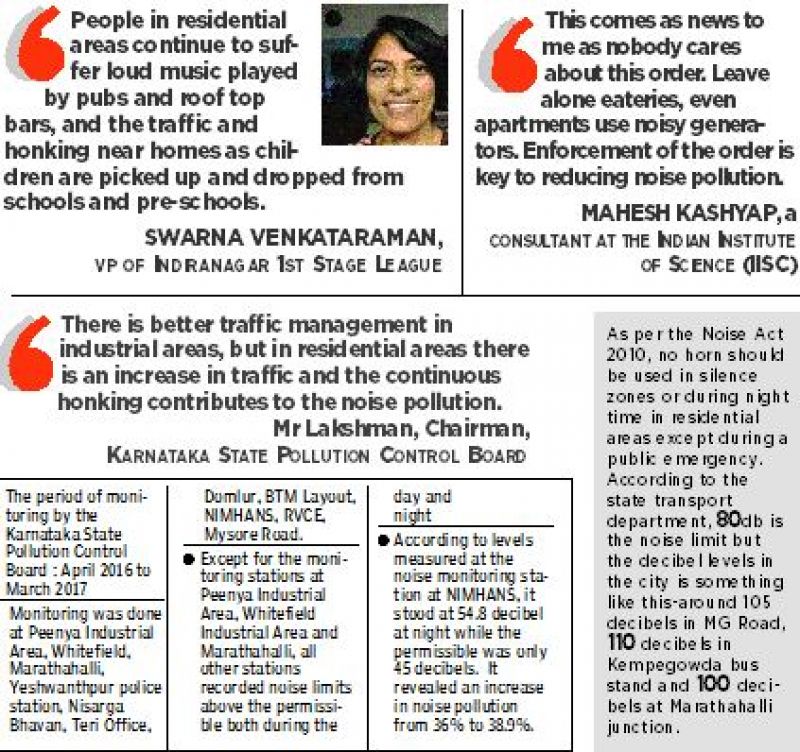Honk, honk! It can't get noisier than this!

Noise pollution levels have soared well above permissible limits in residential areas, as the city pays the price for rampant commercialisation. Data from the Pollution Control Board shows a marked increase even in 'silent zones', which it claims is due to more vehicles on the roads, venues playing loud music and very few rules to clamp down on violators. Monitoring units where commercial activity is on the rise might help tackle the problem, report Aknisree Karthik and Aksheev Thakur.
Bengaluru may still have a lot going for it in terms of its weather and vibrant lifestyle, but the pluses are fast disappearing under the onslaught of commercialisation and so- called development. It’s not only the trees that are vanishing but also quiet neighbourhoods with the concept of a residential area taking a beating of late as shops , pubs and restaurants open in their midst, stealthily growing in number as the authorities choose to look the other way.
And now things have got so bad that going by the latest data of the Karnataka State Pollution Control Board (KSPCB) the noise pollution level is above permissible limits in both residential and sensitive areas. It has risen from 18.0 per cent to 20.7 per cent in the silent zones during the day and from 36.0 per cent to 38.90 per cent at night, it says. And near NIMHANS it has risen to 36.93 per cent during the night, it adds.
Contributing are noisy pubs and bars that pump up their music levels and traffic outside schools and pre-schools when its time to drop and pick up students, complains Ms Swarna Venkataraman, vice-president of the Indiranagar 1st Stage League.
Although the BBMP has made it clear that the mixed zone concept applies only to residential areas with over 40 ft wide roads, illegal establishments have sprung up in areas that have much narrower roads in violation of its diktat, note angry residents. Fed up resident welfare associations have met senior police officers to request them to restrict the nightlife in their neighbourhoods as the bars and pubs are giving them sleepless nights. But this too acheived little.
"Months have rolled by since the BBMP issued a general notice in December last and served individual notices to illegal commercial establishments operating in residential areas. But nothing has come of it," regrets Ms Venkatramana, adding indignantly, “Its not as if we are asking for the moon.We are simply demanding our right to some quiet and peace. Don’t the elders in our homes have the right to sleep peacefully without such disturbance ? Aren't our children entitled to study peacefully in their homes?"
Angered by the inaction of the authorities, the civic activist vows to continue the fight against illegal establishments operating in residential areas till they are driven out and quiet returns to them.
Increased traffic in residential areas adds to noise pollution
It’s a strange phenomenon. While noise pollution in residential areas is above permissible limits, it is within permissible limits in industrial areas of the city, going by the Karnataka State Pollution Control Board (KSPCB).
Its Chairman, Lakshman attributes this to better traffic management in industrial areas. “But due to the increased traffic in residential areas, and the continuous honking, the noise pollution is greater,” he says.
As for the rise in noise pollution at night, a senior official of the board blames it on the order extending Bengaluru’s nightlife upto 1 am last year. With bars and eateries now free to run their businesses until late, they play loud music to please their customers late into the night, he points out. Also the traffic continues on the roads, with all the accompanying honking, he notes.
But Mr Lakshman claims the board is sticking to its promise of last May to monitor the industrial generators at eateries and restaurants which contribute to noise pollution. “We are monitoring the generators at the eateries and restaurants. And directions have already been issued to the outlets to comply with the order issued by the board,” he adds. But the impact is hard to see, point out experts in the field.
“This comes as news to me as nobody cares about this order. Leave alone eateries, even apartments use noisy generators. Enforcement of the order is key to reducing noise pollution,” stresses Mr Mahesh Kashyap, a consultant with the Centre for Sustainable Development, a local NGO.
Mr Kashyap believes there should be regulation of traffic in the silent zone around hospitals, educational institutions and religious places .
Permissible noise pollution levels across residential, silent and commercial zones range between 45 and 70 decibels (day and night respectively).
NIMHANS recorded 54.8 decibels, only at night!


